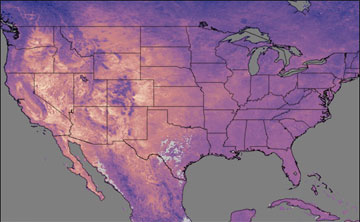NASA: U.S. may face extreme summer warming
NASA: U.S. may face extreme summer temperatures
Average summer high temperatures of 110 in Chicago, D.C. by 2080
mongabay.com
May 9, 2007
A new NASA study warns that the eastern United States could experience extreme warming by 2080, with average summer temperatures rising 10 degrees Fahrenheit.
“There is the potential for extremely hot summertime temperatures in the future, especially during summers with less-than-average frequent rainfall,” said lead author Barry Lynn of NASA’s Goddard Institute for Space Studies and Columbia University, New York.

2005 Heatwave in the United States. NASA image created by Jesse Allen, Earth Observatory, using data provided courtesy of Dr. Z. Wan, MODIS Land Science Team. |
The research, published in Journal of Climate, suggests that in “extreme seasons — when precipitation falls infrequently — July and August daily high temperatures could average between 100 and 110 degrees Fahrenheit in cities such as Chicago, Washington, and Atlanta.”
The study, based on three decades of observational temperature and precipitation data, used computer model simulations factored in expected soil, atmospheric, and oceanic conditions and projected 2 percent annual rise in greenhouse gases. The authors say their model is more accurate than global models used by the Intergovernmental Panel on Climate Change (IPCC).
2006 was the third warmest year on record for the United States, just cooler than 1998 and 1934, while the 2006-2007 winter was the warmest ever.
Last month researchers at Columbia University’s Lamont Doherty Earth Observatory warned that climate change could turn the American southwest into a “Dustbowl.”
This article is based on a news release from NASA’s Goddard Institute for Space Studies.














